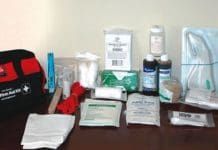Home Search
nail injuries in dogs - search results
If you're not happy with the results, please do another search
First Aid Kits for Dogs: What You Want, What You Need, and What’s Inessential
Every owner should have a first-aid kit for their dogs. But what should be included in that kit? If you're looking for a definitive answer, you'll need to pull out your crystal ball, because there's no telling what you might need in an emergency, since there are infinite ways your dog can be injured. To be prepared for every possible scenario, you'd need a fully stocked van. It really can't be done and shouldn't be done because that's not what first aid" is all about. "
Hot Spots and Lick Granulomas
Your dog has a weeping, oozing wound on her leg or a yucky red blob on the top of her head, and at first you wonder how she injured herself. But if you've been around the dog-care block, you realize that it isn't a cut or scrape. That gooey mess might be diagnosed as pyotraumatic dermatitis, wet eczema, or a Staphylococcus intermedius infection, but it's what everyone calls a hot spot.
A Dog Owner’s Risks and Responsibilities
I do things with my dogs practically every day that would make other dog owners frown with disapproval – and my friends and neighbors...
Lessons From the Camp Fire Aftermath
At the peak of the Camp Fire emergency, over 2,000 animals were in temporary shelters in a number of locations. This included large animals horses, donkeys, cows, goats, sheep, pigs, and llamas who were all taken to a local fairgrounds, where they were held in pens much like any they had ever been held in. I'm sure they experienced some anxiety, but given that their feed and housing was not much different than what most of them had experienced before, I would hazard a guess that they were more or less none the worse for wear. I'd guess the same could be said for the barnyard poultry: hundreds of geese, ducks, and chickens who were also evacuated or rescued from the fires. Lots of these birds were held temporarily at the shelter where I spent the most time volunteering, and they all seemed mentally and physically just fine, even the ones being held in crates in the medical treatment rooms while under treatment for injuries or illness.
Prescription Drugs for Dog Arthritis Pain Relief
Hundreds of drugs developed for human pain are used by veterinarians to treat chronic pain in dogs, but only nonsteroidal anti-inflammatory drugs (abbreviated as NSAIDs and pronounced EN-seds") and two non-NSAID prescription drugs (Galliprant and Adequan) have been approved by the U.S. Food and Drug Administration (FDA) for canine use. For many veterinarians
Make Vet Visits Less Scary
Vet visits can be stressful for the beings on both ends of the leash! As my dog sits in the waiting room, awash in trepidation, I, too, am often worried about what decisions I'll need to make regarding diagnostic testing, what it's all going to cost, and the pros and cons of every possible scenario all while battling an overall concern for my dog's physical and emotional health. Veterinary care is a necessary part of responsible dog ownership, and, fortunately, a little pro-active planning and thoughtful training can help reduce vet-related anxiety for both dogs and their owners. The following tips will help prepare you and your dog for your next trip to the vet's office.
Herbal Remedies for Your Dog’s Arthritis Pain
While its true that some herbs recommended for use with canine arthritis have drug-like actions, including contraindications and potentially adverse side effects, the plants mentioned here are easily acquired from reputable sources, widely used, and safe for most dogs. The descriptions that follow include safety notes as applicable.
Cayenne for Canines: They’re Not Too Hot!
Since 1985, the International Herb Association has announced its Herb of the Year during National Herb Week, which this year is May 1 through 7. The IHA has just published Capsicum: Herb of the Year 2016, a book that reviews chili peppers and their growing conditions and uses, and the organization helps garden centers and herb farms promote its featured plant.
Tips for Giving a Dog a Bath at Home
Giving your dog a bath is sort of like mixing a cocktail, or hitting a golf ball: It seems deceptively straightforward, but you need a lot of background knowledge to really master it. From what kind of shampoo to use to how frequently your dog should be sudsing up, there are all kinds of technical questions to consider before grabbing that spray hose and going to town. But there are also deeper issues at play: Nothing quite lays bare the state of your relationship with your dog like trying to negotiate that slippery expanse of porcelain together. Here are some tips for smooth sailing, at bathtime and beyond.
Updated Alternative Treatments and Supplements
Whole Dog Journal readers often try techniques and products described in the magazine, but sometimes years go by before we need something we read about, or it disappears from the market, or we have trouble finding it, or we simply forget all about it. Last month we revisited systemic oral enzymes and EMT gel, and our September issue revisited green tripe, Seacure, and Willard Water. Here are three more go-to products featured in previous issues that might now be perfect for you and your dog.
Less Stressful Veterinary Visits
A training friend suggested that I read Low Stress Handling, Restraint, and Behavior Modification of Dogs and Cats, by applied animal behaviorist Sophia Yin, DVM, MS. As an owner whose dogs have taken their fair share of visits to vet clinics, I really liked what I read. Dr. Yin's text takes a critical look at how our pets are often handled in veterinary clinics and it's not pretty, as you may have seen yourself. Fortunately, she also offers common sense advice on approaching veterinary care so as to make it as stress-free as possible for our pets. Popular myths abound that force is needed to get animals to behave. Instead, Dr. Yin focuses on how to modify behavior quickly in a veterinary setting using a systematic and positive approach. Her methods involve classical conditioning to change the pet's emotional state; setting up the veterinary environment to ensure the pet's comfort; teaching us how to handle animals with appropriate, rather than stronger, restraint; and how to behave around animals so as to avoid creating problems.
How to Keep a Dog Calm After Surgery
and then waits for Tater to offer an approximation of "dead." (Above) Once Tater offers "dead











